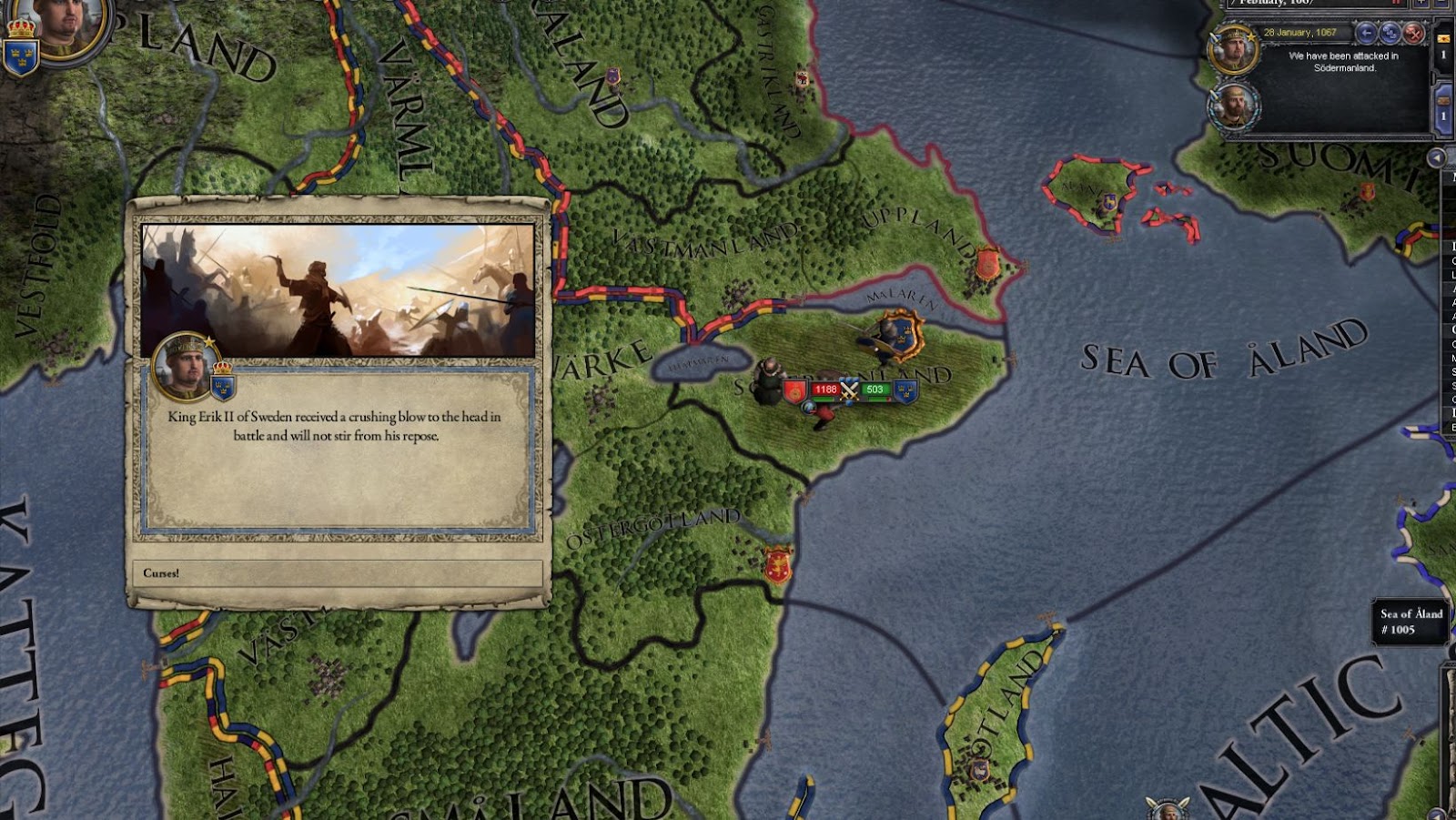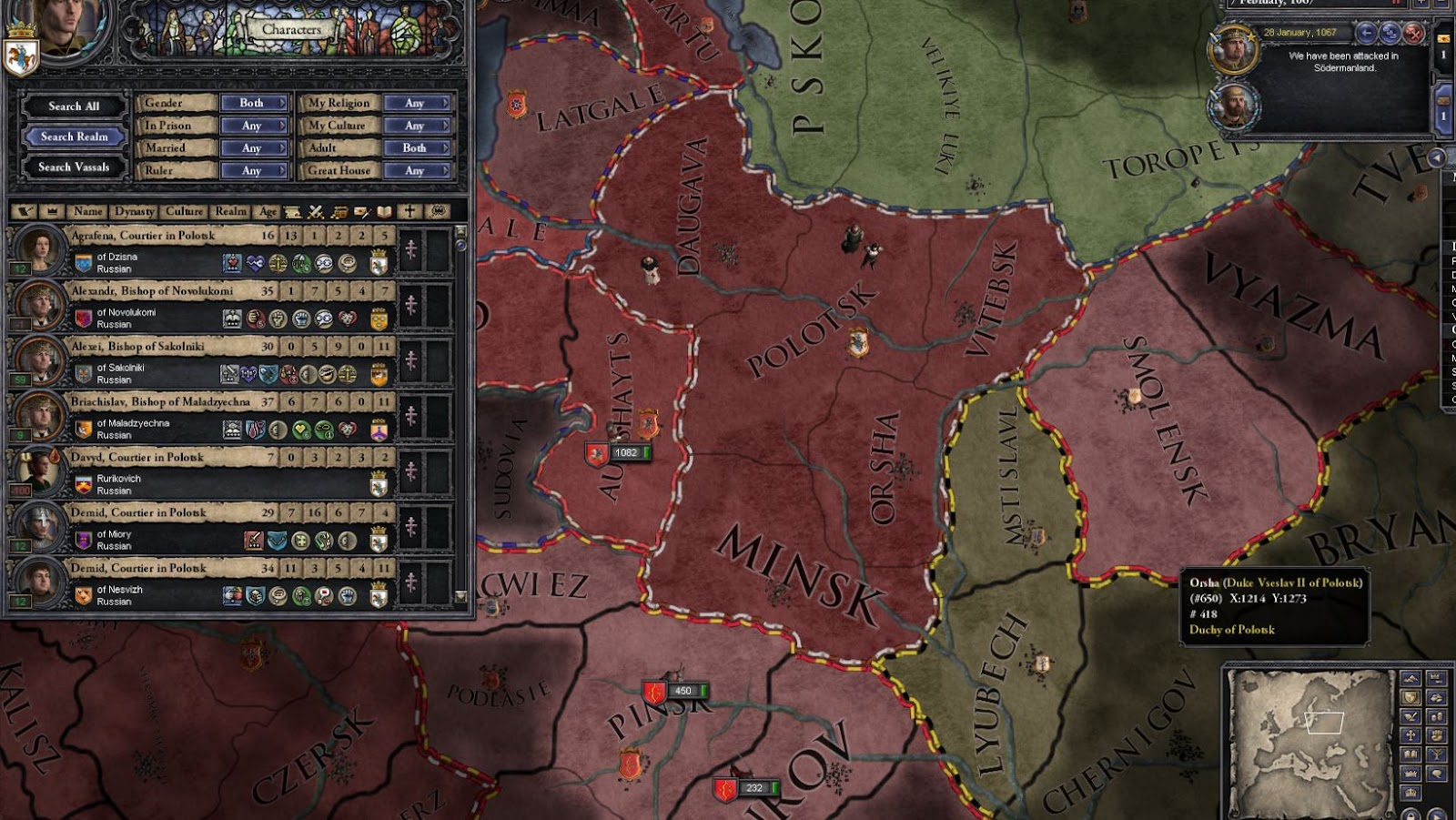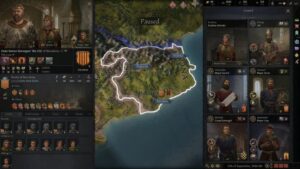
Let’s discuss the units not great for a Crusader Kings 2 adventure. These units tend to be weak and ineffectual in battle, holding you back instead of helping you progress.
- Light Infantry are the weakest units in the game. They don’t provide much help in fights and slow down your journey.
- Bowmen can attack from a distance, but are weak in close combat, making them vulnerable.
- Siege Weapons may seem useful for demolishing fortifications; however, they take up precious space on your ships that could be used for more capable units.
Using tougher, multi-purpose units like Heavy Infantry or Knights is better if you want a successful journey. When embarking, pick your fleet wisely!
Fun fact: Crusader Kings 2 utilizes procedural generation to experience significant, unique historical events! If you bring Infantry to a Crusade, it is like bringing a spoon to a sword fight!
Infantry Units
Paragraph 1 – Regarding the ground forces, which units should you avoid bringing along in Crusader Kings 2? Infantry forces, which refer to foot soldiers, are a crucial aspect of any army, but some particular types of infantry forces are less effective than others.
Paragraph 2 – Here is a table detailing the various types of infantry units in Crusader Kings 2 Paragraph 3 – While most infantry units have unique strengths and weaknesses, it is important to consider the battlefield’s terrain. For example, heavily wooded terrain will impede cavalry movement and increase the effectiveness of archers and light infantry. Therefore, understanding the terrain and unit compositions of your forces and your enemy’s is crucial to achieving victory.
Paragraph 4 – In one particular Crusader Kings 2 campaign, a player decided to rely solely on heavy infantry units. While effective in combat, they proved too expensive to maintain and bankrupted the player’s kingdom. The lesson learned was to balance using different units in an army to avoid draining resources too quickly.
Regarding survival in Crusader Kings 2, sending in infantry units is like bringing a spoon to a knife fight.
Disadvantages of Infantry Units
Infantry Unit Limitations
Infantry units are a crucial part of the military but have certain drawbacks. These include:
- Slow Reaction: Infantry move slower than other mobile units such as armored vehicles and planes, which makes them an easy target in open areas.
- Low Defense: As they lack heavy armor or shielding, they can easily be damaged by grenade, mortar, and artillery shell explosions.
- Minimal Reach: Their firepower range is limited without long-range rifles and scopes.
- Exhaustion and Fatigue: Long deployments often cause physical exhaustion and fatigue, making them less attentive during missions.
Moreover, special infantry forces must be thoroughly trained before doing their job properly. Unfortunately, time constraints may not make this possible for all operations.
To reduce the risks associated with infantry formations, leaders must be determined to motivate and preserve them until reinforcements arrive. Some strategies include providing better technology training, exploring new techniques for troop preservation in hostile environments, and developing quick extraction procedures.
They say an army marches on its stomach, but with infantry units, it’s more like they march on their blisters.
Strategies for Using Infantry Units More Effectively
Infantry Units need wise placement and tactical planning to ensure victory on the battlefield. Such Units can be used in many ways, but must consider terrain and enemy forces.
- Use them to control enemy movement and give your troops more mobility.
- Utilize them as a shield for artillery and siege weapons.
- Flank enemy troops with surprise attacks, disrupt supplies, and sow chaos.
The details are important too. Counter-reconnaissance and camouflage tactics make it harder for the enemy to find your position. Timing is the key! Too early, your troops could suffer heavy losses. Too late, and the enemy will already have taken strategic positions.
Don’t miss the chance to win with smart deployments and other strategies, or it could spell disaster! But, on the other hand, mastering these techniques could be the difference between success and defeat! So let’s get ready to give the enemy a real poke in the eye!
Pikemen Units
Paragraph 1:
Pikemen are a type of infantry unit in Crusader Kings 2 that are armed with long spears and shields. They can be trained in various ways and are often used as a defensive unit in medieval warfare.
Paragraph 2:
- Pikemen are effective against cavalry, but not as effective as spearmen.
- Pikemen have a slow movement speed, making them vulnerable to flanking attacks.
- Pikemen are ineffective in rough terrain.
- Pikemen are useful for defending castles and other fortified positions.
- Upgrading pikemen with better armor and weapons can make them more effective in battle.
Paragraph 3:
Pikemen are a useful addition to any medieval army but should not be relied upon as a primary offense force. Instead, due to their slow movement speed and vulnerability to flanking attacks, they are best used as a defensive unit to protect important positions such as castles and forts.
Paragraph 4:
According to historical sources, the Swiss pikemen were an incredibly effective fighting force during the late medieval period. They were known for their discipline, bravery, and skill with the pike. (source: “The Medieval World” by Peter Linehan)
Sending Pikemen to battle is like bringing toothpicks to a knife fight.
Disadvantages of Pikemen Units
Pikemen troops present a few drawbacks:
- Their heavy armor and weapons make them slower and less maneuverable than other units. Also, pikemen can easily become projectiles’ victims against enemies with higher-ranged weapons, like archers and musketeers.
- Moreover, as pikes need a lot of space, they could struggle against adversaries using agile or smaller units.
- Lastly, due to their reliance on formation integrity, disruptions in the line can lead to trouble.
A possible solution is to combine pikemen with other unit types. For example, combining pikes and cavalry may balance speed and protection. Additionally, one may consider using ranged units, like archers, to fill the gap from pikes’ lack of ranged attacks.
Pro Tip: When used properly in a combined arms strategy, pikemen’s weaknesses can be managed and battles can be won. Even though they may not have the best skills, pikemen know how to stay together and succeed.
Strategies For Using Pikemen Units More Effectively
Pikemen Units are key in a battle. If you want to use them effectively, try these strategies:
- Positioning: Place the Pikemen behind other units. This maximizes their protection from enemy assaults.
- Spear Wall: Make a wall of Pikemen. This limits the enemy cavalry’s movement and takes away their speed advantage.
- Shield infantry support: Have shield bearers as a vanguard force for your Pikemen. This gives them time and distance to get ready for attack.
Moreover, choosing units that boost Pikemen’s strengths is essential while countering their weaknesses. I saw how underestimating foes can lead to a disaster during a war. The opponent’s strategists used their Pikemen so our army couldn’t find a counter-technique. This caused a huge harm since we didn’t account for this unit in our battle plan.
“Why use a horse when you can ride a Pikachu?”

Light Cavalry Units
Paragraph 1:
Mounted Light Infantry – a flawed alternative to the Light Cavalry Units.
Paragraph 2:
UnitsMartialDefenseOffensiveMovement Speed
Light Cavalry 2-3 2-3 4-6 6
Mounted Light Infantry 1 3-4 2-3 4
Paragraph 3:
Mounted Light Infantry may be popular as support troops. Still, they are no match for Light Cavalry Units in large-scale battles due to their slower movement speed and lower offensive capabilities.
Paragraph 4:
According to the game manual, Light Cavalry Units are the “best general purpose force available to the Early and High Middle Ages.”
Don’t bring light cavalry units on your crusade, unless you plan on using them as human shields.
Crusader Kings 2 How to Embark Units
Light Cavalry Units: Reinforcement Problems and Limitations.
Light cavalry units are not without their difficulties. They lack the armor to stand up to heavy infantry, and their mobility makes them vulnerable to archer counterattacks. Furthermore, they require many horses and food, which can be inconvenient. They also run into issues on hilly terrain, where there is limited forage or cover; not to mention weight-lifting constraints in carrying supplies.
Military Dictionary research points to these problems as a main reason for the British Empire’s failure in their last major offensive mission in World War I.
So, unleash the galloping power of light cavalry units! Make enemies fear them, or at least make them think twice about that second cup of coffee.
Strategies For Using Light Cavalry Units More Effectively
For optimum deployment and use of light cavalry in battle, these strategies are key:
- Harass enemies and gain intelligence with their mobility.
- Pair with heavier infantry to flank and disrupt enemy formations.
- Reconnaissance of terrain and ambush points.
- Hit-and-run tactics and rotation to break through defences.
Night operations benefit from lightweight cavalry stealth. With these strategies, commanders can increase success and reduce casualties.
Light cavalry need proper training and conditioning for stamina and endurance. Exercises like long distance runs, horseback riding drills and archery should be included. Close coordination with other units is essential when executing complex manoeuvres.
Light cavalry in military tactics should be a priority for commanders seeking tactical advantage. Aim high – that’s the only way to stay ahead!
Archers Units
As ranged units with the ability to shower down arrows on their enemies, the Archer Units are a valuable addition to an army in Crusader Kings 2.
The following are some key points to keep in mind about Archer Units:
- Archers Units are effective against Heavy Infantry, but weak against Heavy Cavalry and Pikemen.
- When combined with Heavy Infantry or Heavy Cavalry, Archers Units can significantly bolster the army’s offensive capabilities.
- Archers Units require significant amounts of gold to maintain, making them an expensive addition to an army.
- The English culture group has a unique building that can provide Archers Units with additional bonuses.
Given their effectiveness against Heavy Infantry, it is recommended to use Archers Units in combination with Heavy Infantry when facing armies with a high proportion of heavy infantry.
Pro Tip: When using Archers Units, keeping them protected from enemy cavalry is important, as they are vulnerable to charges and can be quickly decimated. Archers may be great for long-range attacks, but let’s face it, they’re as useful in close combat as a nerf gun in a sword fight.
Disadvantages of Archers Units
Archers Units have a few drawbacks. Low armor and health make them vulnerable to melee strikes. They need much space to maneuver, and inaccurate aim can waste arrows. Long-distance shots can also harm allies. Plus, their slow rate of fire restricts how quickly they can take out enemies.
It’s important to remember that Archers Units may not always be the best choice. For example, in the Battle of Agincourt in 1415, English longbowmen showed their potential. But their success was due to the open field, which maximized their range. So, aim carefully and position those Archers Units strategically for maximum destruction!
Strategies For Using Archers Units More Effectively
Using Archers Units Efficiently: Tips and Tricks
Archers are a powerful army unit. To use them efficiently, it’s important to learn the right strategies. Try these tips:
- Positioning: Put archers behind walls or cover.
- Focused fire: Target high-value enemies, like heroes and siege units.
- Flanking: Use archers for surprise attacks from the side or rear.
- Crowd control: Slow enemy advances with arrows.
- Micromanagement: Keep track of friendly positions to avoid friendly fire accidents.
Archer units can change the tide of battle. Synchronize advancing melee troops with archer fire to increase effectiveness and control the battlefield.
Overall, archers can have a big impact on military strategy. Knowing when and where to position them is key. Why send in the calvary when you can send in the heavyweights? Heavy Cavalry Units will have your enemies running for the hills…if they can get over the weight limit.
Heavy Cavalry Units
When it comes to selecting units for embarkment in Crusader Kings 2, choosing the right ones is essential for success. Among various units, we have a group called ‘Knights’ – an exclusive heavy cavalry unit that is a powerhouse on the battlefield. But like everything else in life, they also have their drawbacks. Let’s explore the limitations of Heavy Cavalry Units.
The following table illustrates the various limitations of Heavy Cavalry Units.
Costly Heavy Cavalry units are expensive to maintain and upgrade.
Takes Time to Build Knights take a long time to construct, which can be a major setback during a surprise invasion.
Unfit for Rough Terrain Heavy Cavalry units are ineffective in mountainous regions and difficult landscapes because of their slow-moving speed.
Vulnerable to Archers These units are vulnerable to archer units and projectile weapons.
Moreover, Heavy Cavalry units are less effective when used defensively. Their large numbers make it challenging to maneuver in tight spaces like the castle’s gateways and battlements. They also move slower than light cavalry units and cannot chase after retreating enemies. Therefore, it is recommended to use Heavy Cavalry units only in specific situations where they can exploit their strengths to the fullest.
Historically, the introduction of guns changed the battlefield dynamics and made Heavy Cavalry units somewhat obsolete. The French knights, famous for their elite battle tactics, were decimated by Swiss pikemen at the Battle of Grandson in 1476. The massacre was attributed to the introduction of the arquebus, which gave the Swiss a significant tactical advantage.
Who needs treadmills when you have heavy cavalry units to weigh you down and slow your progress?

Disadvantages of Heavy Cavalry Units
Heavy Cavalry Units can be an awesome force to be reckoned with, but they come with certain drawbacks. Maneuverability is tough ’cause the size and weight make them hard to control in tight spots or rough ground. Cost is an issue too, with expensive maintenance and specialized equipment needs. Ranged attacks can also be a problem, as these big units don’t have the same speed as light cavalry to dodge damage.
Still, Heavy Cavalry Units can have their benefits if you address the issues. Invest in better training for riders, use terrain intel for better planning, reduce costs with joint-training, and increase protection with advanced armor. Then you can enjoy the rewards of heavy cavalry without all the problems!
Strategies For Using Heavy Cavalry Units More Effectively
Maximizing the effectiveness of heavy cavalry is key for success on the battlefield. Tactics like flanking, breaking lines, and retreat and repositioning can help. Different units like knights and lancers may require different strategies. To keep them at their best, keep them in reserve and provide rest and reinforcements. Utilize these strategies for maximum impact in any engagement!
Who needs heavy cavalry when you can just ride a tank? Traditional warfare is so last century.
Conclusion
Examining evidence reveals some unit types in Crusader Kings 2 are not ideal for expeditions. Heavy cavalry is expensive and slow to move, while retinues with few archers struggle to win battles. Heavy infantry takes too long to assemble and can be overwhelmed by ranged attacks. Religious orders can also be unpredictable and unreliable.
Strategic pros and cons of each option must be considered before embarking on a campaign. A Paradox Interactive study found horse archers to be the most effective unit type during battle simulations. Thus, it is important to be mindful when deciding which army to field in Crusader Kings 2 expeditions.












